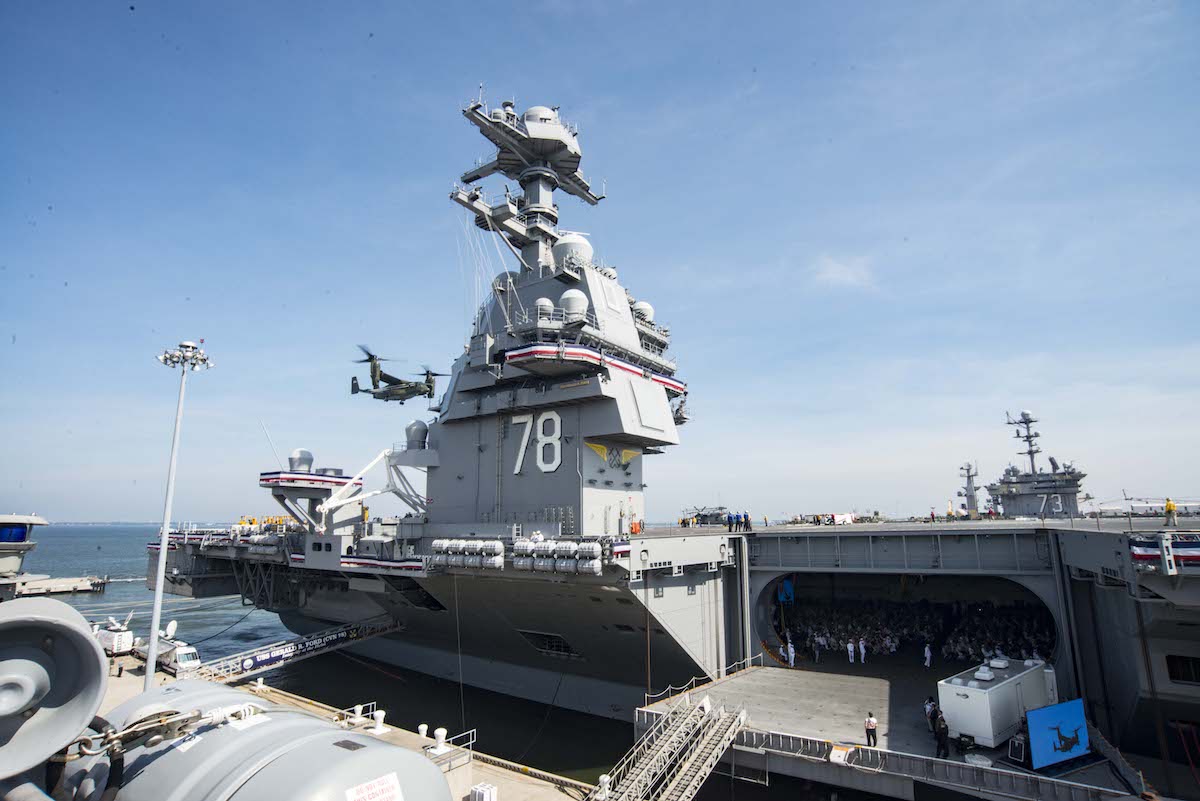and the first new U.S. aircraft carrier designed in 40 years. (U.S. Navy photo by Mass Communication Specialist 2nd Class Andrew J. Sneeringer/Released)
By Tony Capaccio (Bloomberg) –Only two of 11 elevators needed to lift munitions to the deck of the U.S. Navy’s new $13 billion aircraft carrier have been fully installed, according to a Navy veteran who serves on a key House committee.
“I don’t see an end in sight right now” to getting all the elevators working on the USS Gerald R. Ford, the costliest warship ever, Democratic Representative Elaine Luria of Virginia said in an interview. The ship was supposed to be delivered with the Advanced Weapons Elevators, which are moved by magnets rather than cables, working in May 2017.
It’s another setback for contractor Huntington Ingalls Industries Inc. — and for the Navy, which had said in December it planned to complete installation and testing of all 11 elevators before the Ford completed its post-delivery shakedown phase this month, with at least half certified for operation.
Instead, the shakedown phase has been extended to October and the vessel won’t have all the elevators fully installed — much less functioning — by then, according to Luria, a 20-year Navy surface warfare officer whose served on two aircraft carriers and as shore maintenance coordinator for a third.
“Essentially, the ship can’t deploy,” Luria said. “It can’t carry ammunition.” She said the Navy and Huntington Ingalls are trying to solve new problems with doors and hatches lining elevators shafts that don’t meet specifications.
Navy Secretary Richard Spencer said in January that he told President Donald Trump to fire him if the service couldn’t fix the weapons elevators by July. Instead, Trump praised the Ford as “phenomenal” on July 22.
The Ford’s Advanced Weapons Elevators are designed for the carrier’s crew to move as much as 24,000 pounds of ordnance at 150 feet-per-minute, up from the 10,500 pounds at 100 feet-per-minute on the older Nimitz-class carrier. That would increase by more than 30% the number of combat sorties that could launch from the carrier over 24 hours, according to the Navy.
The elevators aren’t the only issue plaguing the ship, which has had problems with two other core systems — the electromagnetic system to launch planes and the arresting gear to catch them when they land.
Senate Armed Services Chairman James Inhofe on Wednesday questioned Vice Admiral Michael Gilday, Trump’s nominee for chief of naval operations, about the vessel’s progress during his confirmation hearing.
“The ship was accepted by the Navy incomplete, nearly two years late, two-and-a-half billion dollars over budget, and 9 of 11 weapons elevators still don’t work with costs continuing to grow,” Inhofe said.
‘Failure of the Navy’
Gilday, in response, said of the costly carrier’s shortcomings that “ultimately, I would consider that a failure of the Navy.”
Beci Brenton, a spokeswoman for Huntington Ingalls, said in an email that “we continue to work closely with our Navy partners to resolve the issues.” She said the Newport News, Virginia-based shipbuilder is “committed to working through the remaining build and test challenges on this system as quickly as possible, and to test, certify and turn over all” 11 elevators “safely and efficiently.”
Captain Danny Hernandez, a Navy spokesman, said because of the “concurrent nature of elevator development and construction” they “have been test beds for discovering developmental issues that have delayed the turnover to the crew.”
He cited “tight tolerances” and “physical structures adjustments,” references to the new problems with 70 elevator shaft doors and 17 hatches that don’t meet design specifications.
“The remaining 9 elevators, not turned over to the crew, are in various levels of construction to ensure the remaining doors and hatches can repeatably operate per required specification,” Hernandez said.
Fixing the problem is “a very time-intensive process of alignment where things are welded on” and have to be cut off and rewelded and realigned, Luria said.
“I think they have the technology and capability to do it, it’s just incredibly time-consuming to do this for nine more elevators,” she said.

 Join The Club
Join The Club











